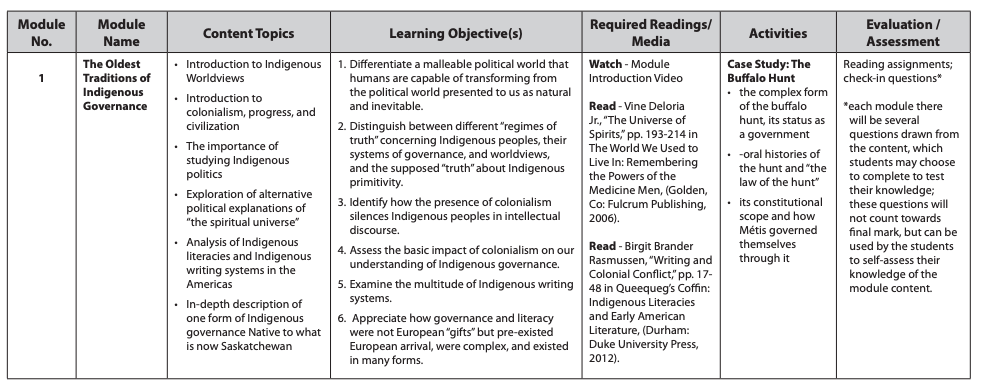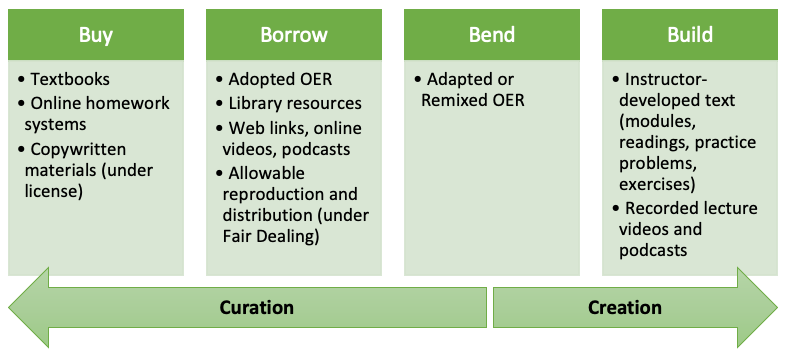An important part of the design and planning process for a new learning experience (like in the design of an online course) is deciding on where the learning materials or course content will come from. Typically, there will be multiple types of material and sources of content, and the course creator has to make content selections that balance factors like cost, time, fit, and effort. This post will introduce a simple framework for thinking about the task of course material selection, some factors to guide decision-making, and some resources to help during the selection process.
Filling Your Blank Canvas
Whatever approach you use for creating your course framework (at the DEU we typically use some version of the Course Design Plan template), at the early stages your learning experience plan will feel like something of a “blank canvas.”
The question at hand is basically: What content (materials and activities) will form the basis of learning across the term? While aiming for course alignment, this list of content typically forms the “Required Readings/Media” and “Activities” lists outlined in a course design plan:
While you are compiling that list, the questions that follow become: What materials do you already have? What materials can you source from elsewhere? What materials might you need to build from scratch?
The Buy, Borrow, Bend, or Build Framework
This brings us to the Buy, Borrow, Bend, or Build Framework. This version of the framework is based on ideas that often kick around in the world of corporate learning & development, like this podcast from GP Strategies (n.d.), or in human resources, where the similar B-strategies (Ulrich, 2003) are applied to recruitment and retention of employees.
We will start on the Curation side of this framework, which refers to finding pre-existing learning materials. With curation you are aiming at “not reinventing the wheel”, while on the other side of the framework, Creation refers to making new materials from scratch. While typically less time-intensive than creation, curation still takes considerable effort for finding, reviewing, approving, and collecting appropriate pre-existing materials.
Buy
Buy refers to “off-the-shelf” learning materials that might be purchased for use ($$$). Typically the associated cost is borne directly by students (in the form of a textbook or an access code for an online homework system), but sometimes it is borne by a school or department (e.g., in the purchase of a limited license for copywritten work to be used, or even licensing an entire course from another instutition). Make sure the associated costs represent good learning value — in other words, be careful about asking students to buy a textbook if you only intend to use a small portion of it.
Advantages:
-
- If the materials are a good fit for what you need, it can be the fastest and easiest solution.
Disadvantages:
-
- Often results in considerable costs for students, and can create financial barriers for learning.
- Typically these materials are not easily adaptable or revisable to better fit the needs of local students or your own teaching approaches; sometimes materials cannot be changed or revised at all.
- Introduces the limitations of working with commercial publishers (e.g., keeping up with changing textbook editions).
- Access to materials may be only temporary (e.g., an access code for an electronic textbook might only be good for one term of study).
Borrow
Borrow refers to collecting pre-existing materials that will not have an associated cost for use. This might mean adopting open educational resources (OER), collecting library resources (like journal articles or videos from subscribed databases), sharing links from around the web (including readings, online videos, or podcasts), or creating allowable reproductions of copywritten materials under Fair Dealing (like by scanning 1 chapter out of a textbook).
Advantages:
-
- Cost-free for students.
- Subject-specific Library Liaisons can help you find materials to suit your course and clarify copyright questions.
Disadvantages:
-
- Curation can take a long time.
- Library licenses to journals and databases can change over time, so materials might not be available in subsequent terms.
- Web links change frequently and occassionally online materials can be lost; checking on such links is an ongoing course maintenance task.
Bend
Bend refers to customizing an existing open education resource (OER) by either adapting that content (making allowable edits), or remixing it (combining portions of different OER together into a singular resource). Depending on how much you customize the OER that you start with, and the degree to which you need to add in your own original content, you might be doing both Curation and Creation with this approach.
Advantages:
-
- Cost-free for students.
- Adapting/remixing OER allows for a high degree of customization, without having to start from scratch, so this approach might offer the best balance of time savings vs. customization.
- Contributes to the global open education movement and may benefit learners far beyond your course.
- Supports are available to learn about what is allowable with Creative Commons licenses and open education practices, and in using platforms for adapting/remixing OER (e.g., Pressbooks).
Disadvantages:
-
- Finding appropriate OER can take a long time, and adapting/remixing them requires additional effort.
- Educators typically need additional academic and technical supports when they are new to this approach.
Build
Build refers to creating entirely new learning materials, from scratch. While you might refer to existing content (with appropriate academic citations), you would be creating totally new module text content, worksheets, practice problems, exercises, or recording original lecture videos or podcasts for your learners.
Advantages:
-
- Cost-free for students.
- The educator gets exactly what materials they want to support their teaching.
- Might rely on previous teaching materials (e.g., start with previous classroom lectures and notes).
- Educator-created materials (especially those that feature their voice and/or face) can be an excellent way to humanize an online course and create a sense of instructor presence.
- Faculty have full copyright control of learning materials they create (reserve all rights, or share your work openly).
Disadvantages:
-
- Potentially, this is the most time-intensive approach and requires the highest amount of effort.
What You Don’t Assign: Burn or Bump
While not part of the framework here, you might also consider places in your “Required Readings/Media” and “Activities” lists where you should Burn or Bump something. In the interest of being judicious and intentional with your learners’ time, and with what you ask them to do to meet the course requirements, consider what you might:
-
- Burn: Look for any assigned material or content that is non-essential and can be removed. This might be because it is redundant content, “nice-to-know” and not “need-to-know”, or because it is simply not connected to the learning objectives and assessment of the course closely enough to justify keeping it.
- Bump: If the materials might be helpful to some of your learners, but other learners won’t need it, move it to a “Supplementary Materials” or “Optional Readings” or “Recommended Resources” or “For More Help” list instead. This will encourage learner autonomy and provide supports for those students who need it, without slowing down those who do not.
Photo by Dom J from Pexels




